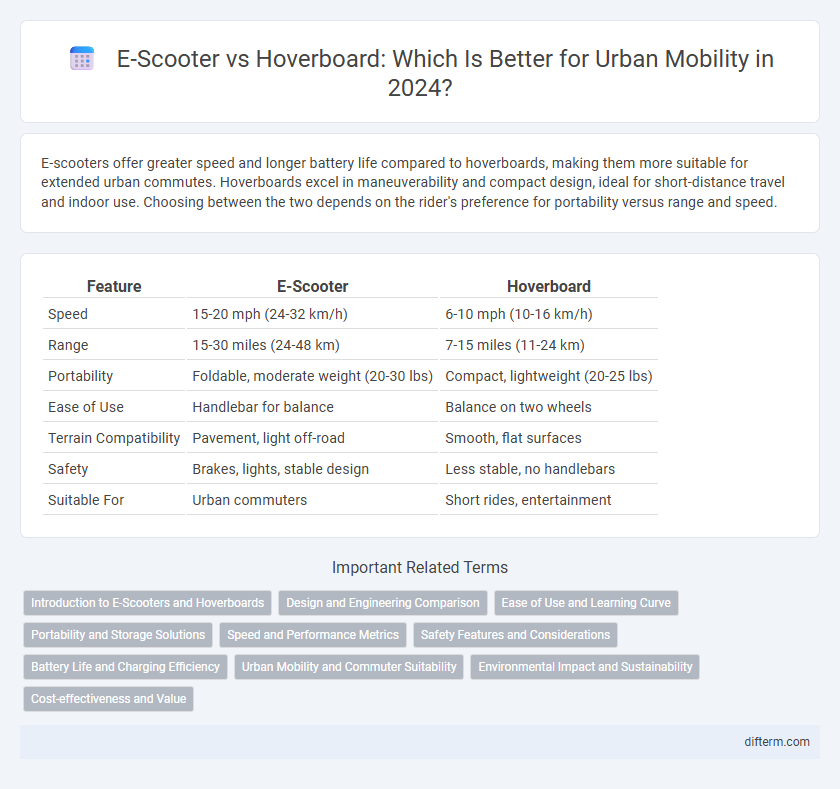E-scooters offer greater speed and longer battery life compared to hoverboards, making them more suitable for extended urban commutes. Hoverboards excel in maneuverability and compact design, ideal for short-distance travel and indoor use. Choosing between the two depends on the rider's preference for portability versus range and speed.
Table of Comparison
| Feature | E-Scooter | Hoverboard |
|---|---|---|
| Speed | 15-20 mph (24-32 km/h) | 6-10 mph (10-16 km/h) |
| Range | 15-30 miles (24-48 km) | 7-15 miles (11-24 km) |
| Portability | Foldable, moderate weight (20-30 lbs) | Compact, lightweight (20-25 lbs) |
| Ease of Use | Handlebar for balance | Balance on two wheels |
| Terrain Compatibility | Pavement, light off-road | Smooth, flat surfaces |
| Safety | Brakes, lights, stable design | Less stable, no handlebars |
| Suitable For | Urban commuters | Short rides, entertainment |
Introduction to E-Scooters and Hoverboards
E-scooters and hoverboards are innovative personal mobility devices designed for short-distance urban travel, combining convenience with eco-friendly transportation. E-scooters typically feature handlebars and electric motors, providing stability and ease of control, while hoverboards operate as self-balancing platforms controlled by subtle body movements. Both devices offer efficient alternatives to traditional commuting methods, addressing the growing demand for sustainable and space-saving mobility solutions.
Design and Engineering Comparison
E-scooters feature a robust frame with a handlebar for stability and precise steering, engineered for urban mobility with larger wheels and suspension systems that handle varied terrains efficiently. Hoverboards incorporate a compact, self-balancing design with gyroscopic sensors and dual motors, prioritizing portability and ease of use but offering less maneuverability and stability compared to e-scooters. The engineering of e-scooters emphasizes durability and control, while hoverboards focus on innovative balancing technology and minimalistic design.
Ease of Use and Learning Curve
E-scooters offer a more intuitive riding experience with a straightforward throttle and brake system, making them easier for beginners to master compared to hoverboards, which require balance and body coordination. Hoverboards have a steeper learning curve due to the need for precise weight shifting to control speed and direction, often resulting in longer practice times before achieving stability. The simpler control mechanics of e-scooters reduce initial user frustration and improve overall accessibility in urban mobility contexts.
Portability and Storage Solutions
E-scooters offer superior portability with foldable designs and lightweight frames that easily fit into backpacks or car trunks, making them ideal for urban commuters. Hoverboards are more compact but bulkier, requiring dedicated storage spaces or carrying bags for transport. Storage solutions for e-scooters often include wall mounts and docking stations, while hoverboards commonly rely on protective cases and compact shelf placement.
Speed and Performance Metrics
E-scooters typically offer top speeds ranging from 15 to 25 mph, outperforming hoverboards that average speeds of 6 to 12 mph. E-scooters provide greater range, often between 15 to 30 miles per charge, while hoverboards usually last 7 to 12 miles. Acceleration and stability are enhanced in e-scooters due to their larger wheels and more robust motor systems, making them better suited for urban commuting.
Safety Features and Considerations
E-scooters typically offer enhanced safety features such as built-in headlights, taillights, and reliable braking systems, which improve visibility and control during rides. Hoverboards, while compact and agile, often lack comprehensive safety components, increasing the risk of falls or collisions, particularly at higher speeds or uneven terrain. When choosing between the two, riders should prioritize protective gear and assess the specific safety technologies available on each device to minimize injury risks.
Battery Life and Charging Efficiency
E-scooters typically offer longer battery life, averaging 15 to 30 miles per charge, compared to hoverboards which generally last around 7 to 12 miles. E-scooter batteries often feature faster charging times, with many models reaching full charge within 3 to 5 hours, whereas hoverboards can take 2 to 4 hours but provide less range efficiency. Advances in lithium-ion battery technology enhance both devices' energy density, yet e-scooters maintain an edge in energy consumption and vehicle range optimization.
Urban Mobility and Commuter Suitability
E-scooters offer greater stability, longer range, and faster speeds, making them more suitable for urban mobility and daily commuting compared to hoverboards. Their compact design and reliable braking systems enhance safety in crowded city environments, while hoverboards often struggle with uneven terrain and shorter battery life. E-scooters also integrate seamlessly with public transportation networks, enabling efficient last-mile connectivity for commuters.
Environmental Impact and Sustainability
E-scooters generate lower carbon emissions per mile compared to hoverboards due to their more efficient battery systems and longer lifespan, reducing overall environmental impact. Hoverboards often rely on lithium-ion batteries that degrade faster, leading to more frequent replacements and increased electronic waste. E-scooters' higher durability and easier recyclability of components contribute significantly to sustainable urban mobility solutions.
Cost-effectiveness and Value
E-scooters generally offer better cost-effectiveness due to their longer range and higher speed, enabling more efficient urban commuting compared to hoverboards. Maintenance expenses for e-scooters tend to be lower, with easily replaceable parts and widespread availability of service centers. Hoverboards, while often cheaper upfront, provide less value over time due to limited functionality and shorter battery life.
e-scooter vs hoverboard Infographic

 difterm.com
difterm.com